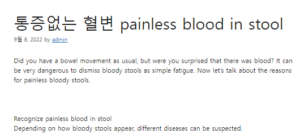Did you have a bowel movement as usual, but were you surprised that there was blood? It can be very dangerous to dismiss bloody stools as simple fatigue. Now let’s talk about the reasons for painless bloody stools.
Recognize painless blood in stool
Depending on how bloody stools appear, different diseases can be suspected.

1. dentition
A dentition is a tear in the anus. In general, it occurs a lot in constipation patients, and it is characterized by bright red bloody stools. At first, the degree of blood on the tissue during post-treatment, but when the symptoms worsen, you will see bright red bloody stools. If constipation is resolved and cleanliness is well maintained, it will be cured naturally, but if it becomes chronic, surgery may be necessary.
2. Firu
A fistula is an inflammation of the anal gland. There is an uncomfortable feeling in the anus, and over time, a feeling of heat similar to a body aching sensation and a headache occur. There is not much bloody stool in the fistula, but it may come out in the stool. If the fistula is left untreated, the inflammation worsens, making daily life difficult and may even develop into cancer. 통증없는 혈변
3. Hemorrhoids
Hemorrhoids are lumps protruding around the anus. When you have a bowel movement, you will see a lump of blood, and symptoms such as anal pain, a feeling of small bowel movements, itching, and protruding hemorrhoids appear. Initially, it can be treated with drugs, but if the timing is missed, it must be removed surgically. 좋은뉴스
4. Colitis
Inflammation of the intestines causes blood to come out of the mucus-like stools. This is because there is a problem with the large intestine itself, so abdominal pain appears along with it, and bloody stool comes out every time you pass a stool. In addition to colitis, inflammatory bowel diseases such as Crohn’s disease and diverticulitis can also show the same symptoms.
5. Stomach Ulcer
Patients with gastric ulcers have dark red stools. This is because it stays in the intestine for a long time after bleeding and hardens with the stool. Symptoms such as indigestion, anemia, etc. may also appear together with stomach pain or abdominal pain.
6. Colorectal Cancer
The worst disease in which bloody stools appear is ‘colon cancer’. A tumor located in the large intestine is injured by the stool and produces blood in the stool. In the early stages, there is no pain and there are almost no accompanying symptoms, so it is easy to pass it lightly. If you lose weight, or if you experience indigestion, vomiting, bowel movements, constipation, etc., you should suspect colon cancer. When colorectal cancer progresses to stage 2 or higher, there is a characteristic that only blood comes out even if there is a feeling of defecation, but no stool.
7. Intestinal cramps
You may have temporary bloody stools due to severe stress, overwork, or drinking. This occurs as the intestine becomes irritated and atrophied, which usually goes away in a day or two. If you continue to have bloody stools over time, it is recommended to have an anal surgery checkup.
concluding remarks
So far, we have learned about painless bloody stools. If you see bloody stools occasionally, most of them are due to stress, so there is no need to worry. However, if it is periodic, it may be due to a problem with the intestines. Recently, there are many bloody stools in their 20s, so if symptoms persist for more than a month, it is advisable to get tested.